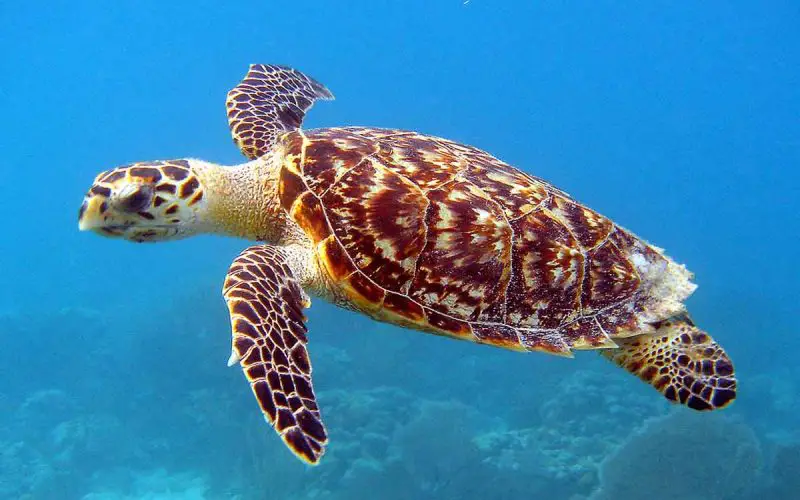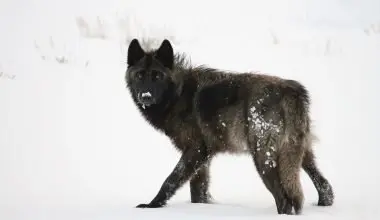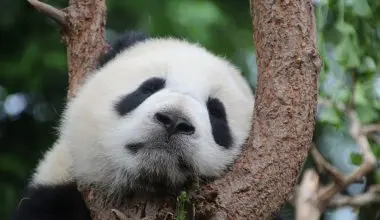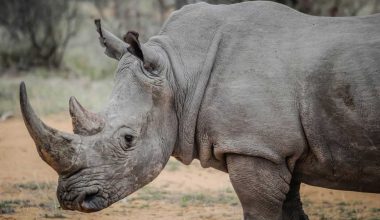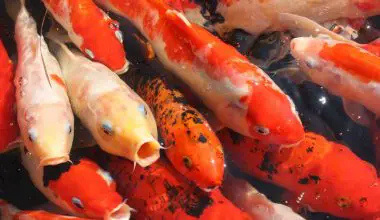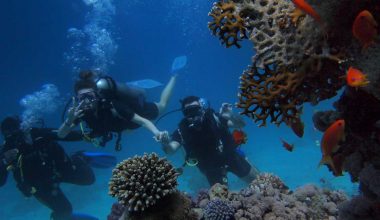Table of Contents Show
Hawksbill sea turtles (Eretmochelys imbricate) closely resemble hawks, hence the name hawksbill. They are not particularly large compared to other sea turtles.
They can grow up to 45 inches in shell length and weigh around 150 pounds. During their youth, their carapace, or upper shell, is heart-shaped and elongates (increases in length) as they mature.
Navigation:
15 Hawksbill Sea Turtle Facts
- Act as gardeners of Coral Reefs
- Slow reproduction
- They live as long as humans!
- Love migrating great distances
- Highly poisonous flesh
- Strong Swimmers
- Skilled Climbers
- Special Protection
- Unique Shell
- Disappeared from Mediterranean
- Shallow waters as playgrounds
- The secret of hatchlings
- Only reptiles Glow!
- Hawksbill Sea Turtle’s Size
- Hawksbill Sea Turtle Habitats
Frequently Asked Questions (FAQs)
15 Hawksbill Sea Turtle Facts
1. Gardeners of Coral Reefs
A single hawksbill can eat 12,000 sponges a year, this is vital in maintain coral reefs as the sponges are the main competitors of coral reef.
Although the sponges usually don’t have many predators and also it is equipped with glasslike needles, it is still eaten up by the hawksbill as it uses its hollowed-out jaw to consume a large meal of sponges.
2. Slow Reproduction
The hawksbill is a solitary creature. It only chooses to reproduce once every 3-7 years after reaching maturity (30 years). The female turtle will also come back to the beach where she was born.
Regardless of the distance she may have to cover, she will come back and lay 60-200 eggs during mating seasons.
3. Maximum age of living is 50 years
This one has mixed opinions, some say it is 30 while others seem to state it is around 50.
4. Love to migrate
Hawksbill is considered to be highly migratory. Recent tracking through satellites during mating seasons shows Hawksbill sea turtles swimming distance of 1,800 kilometers a month.
5. Toxic body
The hawksbill eats a lot of highly poisonous sponges, but that doesn’t stop it either. Its body fat can absorb these toxins into the meat of hawksbill, making it toxic.
Even though its meat becomes highly toxic for consumption, the turtle itself is quite healthy.
6. Strong Swimmers
Although Hawksbill sea turtle weighs around 100 to 150 pounds and is about 2 feet long, it is still one of the smallest turtles.
This allows the hawksbill sea turtle to be agile along with a streamlined body. Hawksbills are claimed to be fastest of all sea turtles.
7. Skilled Climbers
The female turtles can climb over reefs and rocks to carry out nesting. They seek areas with undisturbed deep sand beaches (like in the tropics) for nesting.
After reaching, they may clear away the dry sand with flippers and dig a hole in the sand. The hole in sand is to lay a clutch of eggs for reproduction.
8. Special Protection
They have two sets of prefrontal scales on their heads. Other sea turtles only have one scale to protect their heads.
Hawksbill scales are on each side of their two eyes. Additionally, they also have two claws on either side of the flipper.
9. Unique Shell
Hawksbill sea turtle’s shell is architecturally different from other turtles. The top shell has the classic look of tortoise shell with dark brown or reddish-brown mottling appearance.
10. Disappeared from the Mediterranean
The largest populations of the hawksbill turtle are said to be in Mexico, Australia, Seychelles, and the Caribbean Sea. They are not found near Mediterranean Sea anymore and rarely found in US waters.
11. Shallow waters for playgrounds
They prefer rock areas, coral reefs, lagoons, oceans islands, narrow creeks, shallow coastal areas, and grasses for foraging and nesting.
They are never found in waters deeper than 65 feet.
12. The secret of hatchlings
The hatchlings of hawksbill have been reported to float on algal mats and drift lines of jetsam and flotsam in the Atlantic Ocean.
Once they are 9-10 inches long, the young will move to coastal areas with reef habitats where they will feed on spores.
13. A glowing reptilian
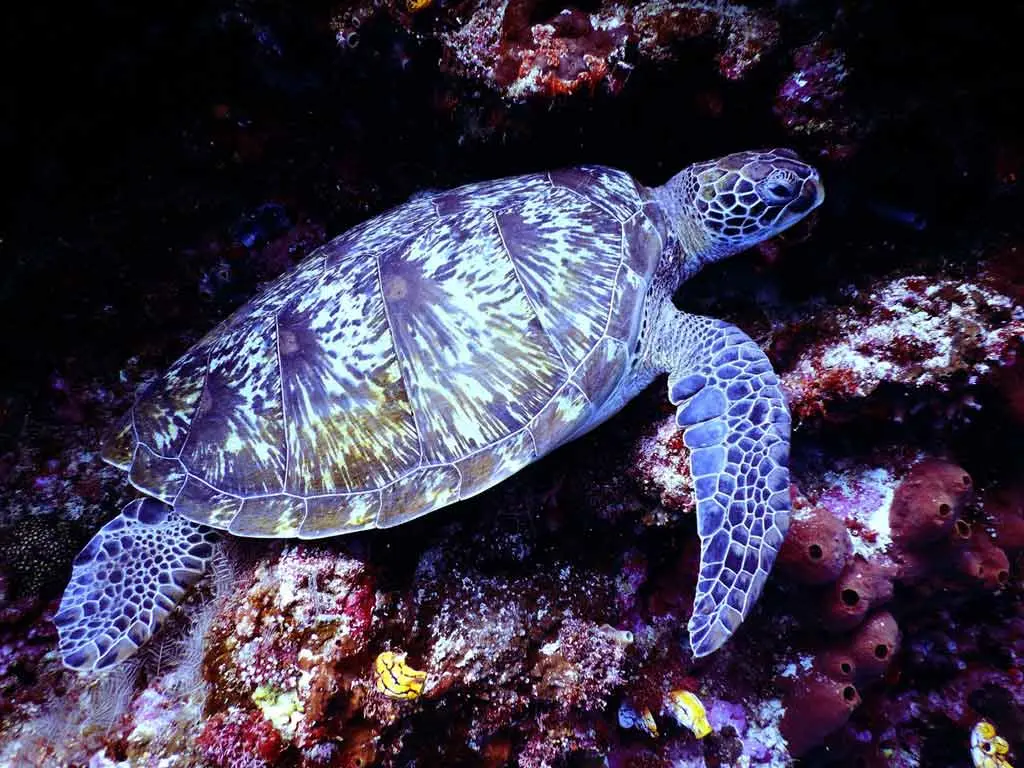
The hawksbill turtle can glow in the dark! It is the only known reptile to be bio fluorescent (glowing In dark). The glow can be reddish, pink, purple, or yellow.
14. Hawksbill Sea Turtle’s Size
Hawksbill sea turtles can grow their shells almost 45 inches in length and they can weigh around 70 kg. That’s the weight of an average human being!
15. Hawksbill Sea Turtle Habitat
These turtles are found throughout the tropical regions of the Indian, Pacific, and Atlantic oceans, where they tend to avoid deep waters, preferring coastlines feeding on sponges.
These migratory reptiles help to maintain a healthy coral reef ecosystem.
Frequently Asked Questions
What does Hawksbill Sea Turtle Eat?
Hawksbill turtles are omnivorous creatures that like to eat marine algae, crustaceans, sea urchins, fish, jellyfish, and mollusks.
Hawksbills are responsible for controlling Sea Urchins population just like Sea Otters.
The hawksbill sea turtle according to The International Union of Conservation of Nature (IUCN) RED LIST has been classified as critically endangered.
Why is Hawksbill Sea Turtle Endangered?
Like many other sea turtles, the hawksbill is also classified as critically endangered species mainly due to human impact. The shells of these tortoises are a prized possession among humans since ancient times of Egypt. And with unique and stunning shells, the hawksbill sea turtle is no exception.
IUCN states that over the last hundred years, millions of hawksbill sea turtles have been killed to carry out shell trading.
Although trading of Hawksbill shells was internationally banned in 1993, illegal trafficking is still ongoing.
People still consume eggs of hawksbill turtles, even though the species is classified as critically endangered. They may be accidentally captured by fishermen as well. Sadly, the turtles are also killed because of their flesh.
As for most animals, cause of endangerment for hawksbill is also widespread habitat loss.
The development of the coastal region has reduced the space available for them to nest, whereas rising temperatures due to global warming are killing coral reefs which are an essential source of food for them.
Hawksbill Sea Turtle Conservation Efforts
The hawksbill is being protected by agreements such as the Convention on International Trade in Endangered Species of Wild Fauna and Flora (CITES) as well as by the Convention on Migratory Species.
This level of cooperation on a global scale is essential for conservation of hawksbills due to their habitats present over a wide geographic range.
